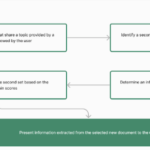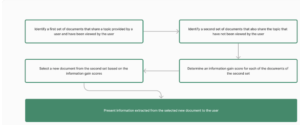Want to reach more of your target audience, connect with them, and have meaningful interactions?
Quality content marketing may be the ideal solution for you.
But gone are the days of simply writing and releasing content.
Effective content marketing requires various skills and strategies if you want to get it right.
If you’re looking to breathe new life into your brand and generate more interest in your target audience, here are the top 10 skills and strategies you’ll need.
1. Know Your Audience And Target Them Effectively
Ask anyone about content and content marketing, and chances are that audience targeting is one of the first suggestions.
But what does audience targeting actually mean? And why is it an essential content marketing skill?
First, understand who your audience is, what their day is like, their priorities, and what they’re doing or intending to do while they consume content.
Then, use that information to craft content that counts on a platform and in a format that suits your audience.
Take the Shoe Snob Blog as an example.
The content is photo-centric. The page has few distractions, and the storytelling and text are dense and chunked.
The topics range from stories of shoemakers, care tips, and all the insider info a lover of bespoke and top-of-the-line men’s shoes, shoe designer, or shoemaker could want to know about the objects of their obsessions.
These features tell us a lot about the blog’s readers.
Shoe Snob Blog readers are likely visual, busy, and view reading the blog’s content as almost a secret pleasure they indulge in while waiting in line for an expensive coffee.
The blog doesn’t have content on saving money, getting things for less, building shoes more cheaply, or reviews of shoes you’d find in your local department store.
Why? That’s not what the blog’s target audience is interested in. In fact, those topics would likely chase readers away.
For Justin FitzPatrick, the blog’s author, it’s about the luxury, the emotional connection and passion for the brands, and the smaller details most of us wouldn’t likely notice about a man’s dress shoe – in language that matches the audience’s expertise.
You might be tempted to skip audience exploration and targeting to this degree, particularly if you’re a B2B brand or sell something non-visual like insurance.
But this could be a fatal mistake for your content marketing.
Even if you’re selling to another company, that company is driven and shaped by humans you’ll need to get attention from.
2. Understand How Brand Strategy Influences Content
Content and content marketing could do more harm than good if they fail to blend seamlessly with a brand strategy.
So, if you’re looking to build content marketing skills, ensure you understand how brand strategy influences effective content.
Solid brand-driven content strategies consist of six core elements when it comes to content:
- Brand foundations – What matters to the company, such as the image it wishes to project, etc.
- Audience discovery and brand position – How the brand fits within the market.
- Keywords and language – How the company wants people to find its brand, and what language it will use.
- Authority building – Looking like an expert and a leader on a chosen topic.
- Content creation – Any content strategy must be manageable, affordable, sustainable, scalable, and effective.
- Organization – Utilizing an editorial and publishing calendar and post-publishing tracking and measurement to maintain and guide your content strategy.
3. Consider SEO, Search, And Search Engines
SEO and search are essential for getting found, gaining traffic, building authority, and overall growth.
If you want your content marketing to work, you can’t afford to avoid this content marketing skill because you’re not an expert.
- Users make 1.2 trillion searches on Google per year.
- 93% of all web traffic comes from a search engine.
- 46% of searches are made to look for something local.
In January 2023, searches for phrases that included “gifts” increased 45%, while searches that included “presents” increased 15% over 2022. This equated to $47 billion in the two weeks following Christmas.
So, search is growing and becoming more important – not declining.
If you want to take advantage of search traffic, you need to ensure you’re considering several aspects of SEO when developing your content marketing skills, including:
- Keyword research.
- AI and how to humanize your content.
- Link building.
- Building authority.
- Topic relevance and expertise.
- Site structure, website performance, and analytics.
4. Humanize Your Content
Once you get started with content marketing, you’ll realize pretty quickly that AI-generated content is highly problematic.
You need to follow basic SEO formulas to have your content rank, another formula to make it interesting and catchy for readers, and how to maximize the usability of your content.
However, you also need to ensure you stand out from the crowd and surpass your competitors.
To make your content more human-friendly, learn how to:
- Create content that supports a user journey rather than search engines or sections of a funnel.
- Utilize customer communications and social channels to understand and connect with your audience. Then, use it to market your content.
- Make use of internal experts. Not only is looking in-house a way to make excellent content more affordable, but audiences also love to see your brand’s passion for what it does.
- Take a smart angle, get personal, and have an attitude. Personality and branding are vital, but so is the information you provide. Ensure it is something of value to your readers, and don’t be afraid to tell stories to build emotional connections.
- Add personal videos to top-performing articles.
One of the best examples of all these tips for humanized content in action is the annual Christmas content campaign from WestJet.
5. Engage By Storytelling And Creative Writing
If you want to capture attention and use content to connect with your audience, you need to be able to tell a good story.
Stories make content emotionally engaging but also make it possible for readers to experience what it would be like if they purchased your product or service.
Want to strengthen your content marketing with storytelling?
- Create relatable, believable content. To do this, know your audience, understand their experiences, and create content that aligns with this knowledge.
- Have a clear message. Like an ad, every story or piece of content needs a goal and a clear message you want to convey to your audience.
- Choose the right type of story. Do you need to make an emotional connection? Compel a reader to act? Convey values, a feature, or a concept? Build community?
- Select the right platform and medium. If you want to share several statistics, video might not be the best option. Selling vacations? YouTube or TikTok might perform better than Reddit or a blog.
- Know where to start and stop. Your content needs to appear at the right point in the customer journey and push readers to the next step. What should readers do next?
- Organize and structure. Plan your content ahead of time. Make sure your stories have an arc, make sense, and take readers or views through an experience.
6. Do Your Research
The best content provides an audience with information or a look at something they normally don’t have access to.
To find this information, you must be prepared for deep research – and that means a lot more than just finding a statistic.
Find the original source or study. Ensure the number you’ve found is still relevant and accurate. Consider the source of the statistic and how they arrived at that number. What did the study not consider when finding their statistic?
To build additional authority, you may consider interviewing the source of a statistic or a subject area expert.
7. Improve Your Interviewing Skills
While it helps if you deeply understand the subject matter, it isn’t all lost if you’re new to the topic.
In fact, being a newbie to a topic can have advantages because you can see the topic with a fresh perspective.
One thing you must be knowledgeable about, however, is interviews. Interviewing is an essential content marketing skill.
Here are some tips:
Prepare
Arrive at the interview with an understanding of the topic. Know the pains and challenges individuals interested in the topic face.
Understand your priorities for your readers, the industry, and the individual you’re interviewing.
Have a list of questions that are thoughtful and organized, and work toward answering a single question or reaching a specific goal.
Set Interview Goal
Are you trying to get tips from an expert? A day in the life of? Solve or bring light to a certain issue? Make a human connection?
Choose a goal for your interview, organize it into an outline, and remove any question or information that doesn’t help you move toward that goal.
Be Personable And Make The Interviewee Comfortable
Awkward silences, a lack of rapport, nervousness, and other social aspects can interfere with an otherwise excellent interview and affect the information you collect.
You may want to consider using cognitive interview techniques, which have been adapted from criminal investigation for journalism.
Record Your Conversation
As humans, our brains prioritize stimuli to determine what is important and what we should pay attention to and remember.
This attentional filtering becomes more severe when you’re making notes, thinking about the technical aspects of an interview, and nervous. As a result, it’s easy to miss important details or implications.
So, save some time and improve your accuracy and insights into the information provided during the interview by making a recording that you can refer to as often as necessary.
Be Precise And Ask For Clarification
Some people love raisins in cinnamon buns. Others do not. And just like the raisins debate, how you define a word or concept may vary greatly from someone else.
So, if the information you collect during an interview seems vague, or you’re unsure of something the interviewee says, ask.
The worst thing you can do is assume that it isn’t true or deliberately influence the meaning of someone’s words.
8. Measure And Track Everything
Measuring something is generally easy. The difficult part of measurement and tracking is measuring and tracking the right things.
SEJ’s annual State of SEO Report reveals that SEO professionals often have a mismatch between their goals, the methods and strategies they use to reach them, and the variables they measure.
Content marketers and marketing are no exception.
Let’s say you want to use content marketing to increase conversions. So, you create a video for your hot tub company.
In this instance, tracking and analyzing traffic data to the video would be a mistake. Those numbers are only part of the story.
Instead, track clicks and use traffic data to better understand who clicks through to your content and where viewers go after they consume it.
And this is vital: Don’t stop your analysis at the click.
Every visit from a viewer is only one step in a larger journey – and this journey matters.
Returning to the previous example, your video might have generated fewer clicks and conversions overall.
Dig a little deeper, however, and you might discover that those few conversions were of much higher value than average, and the viewers return to your site more often than your average site viewer.
In this instance, while traffic numbers might make it look like your video failed, analysis of the customer journey reveals that your video was actually a big success, attracting a more qualified, valuable, and engaged audience.
9. Repackage Content With Purpose
You invest a lot of resources in creating amazing content. Don’t simply publish it in one format and waste the rest of its potential.
Before creating content, consider all the different formats and ways you can share it to get attention.
By planning, you can collect images, video footage, sound bites, expert quotes, and everything you’ll need to share and market your content in various ways to maximize your return on investment (ROI).
But refrain from repackaging content with the sole purpose of spreading it everywhere. Carefully plan your content to appear when and where you need to.
As explained in the video above, Search Engine Journal uses the data gathered for its State of SEO Report to create:
- White paper reports.
- Podcast.
- Articles on data not included in the main reports.
- Infographics.
- Carousels for social media.
- Video clips.
Some of these are released before the main report is published to help spread the word and generate interest while sharing interesting insights about the SEO industry.
Then, when the report is released, it is followed by additional content to help generate interest, links, and findings.
Therefore, instead of a week of interest, the reports generate traffic and attention while informing readers for months without significantly increasing the original investment.
10. Stand Out While Blending In
One of the more common pieces of advice is to copy successful content and do what others are doing.
Makes sense, right?
After all, SEO, good writing, and other skills all have best practices you need to follow. Your audience also has preferences, expectations, and requirements.
Your content needs to look like everyone else’s to some degree.
But here’s the problem with this advice: No one stands out if everyone does things the same way.
Therefore, learning how to blend in while standing out is an essential skill for content marketing.
So, instead of mimicking or copying successful content, collect several examples that have worked on a specific platform or for a specific audience and investigate to find out why they’re effective.
Then, you can use these insights to create and test your own content that allows you to stand out, be unique, and fulfill the needs of your target audience.
Conclusion
Effective marketing is more than choosing the right topic or quality writing.
By strengthening and utilizing these 10 content marketing skills, your content will help you generate the right traffic and connect with your audience in a way that will have you dominating the competition.
More resources:
Featured Image: Viktoria Kurpas/Shutterstock



















